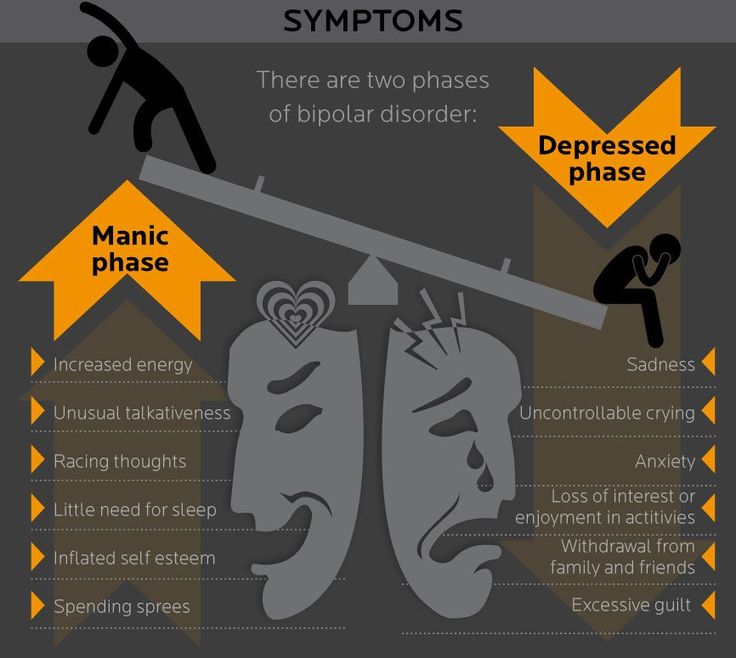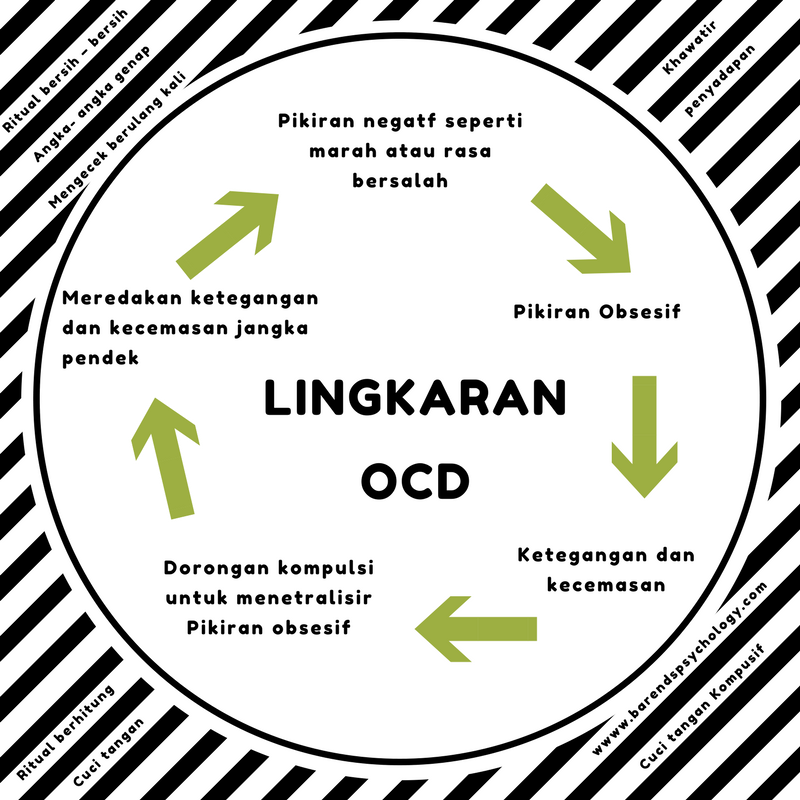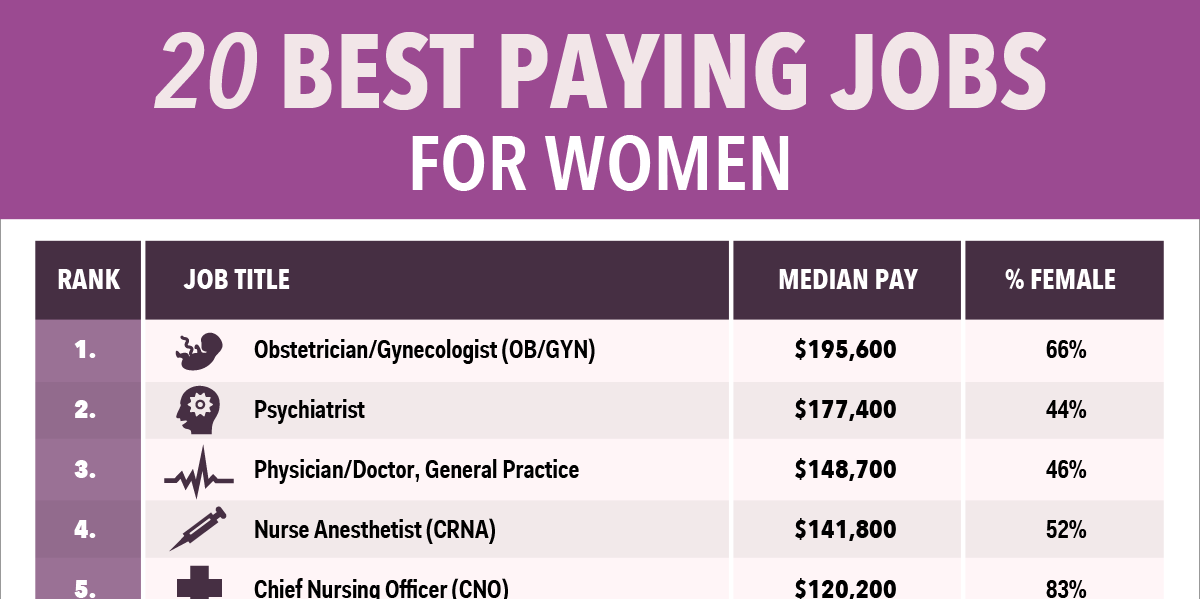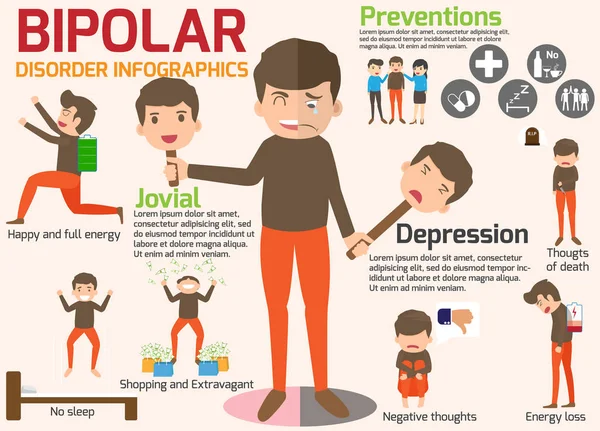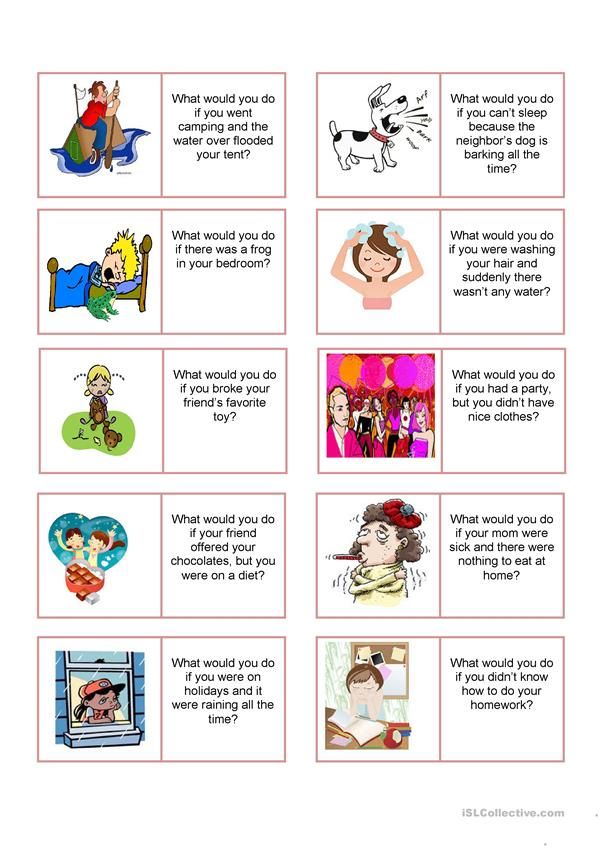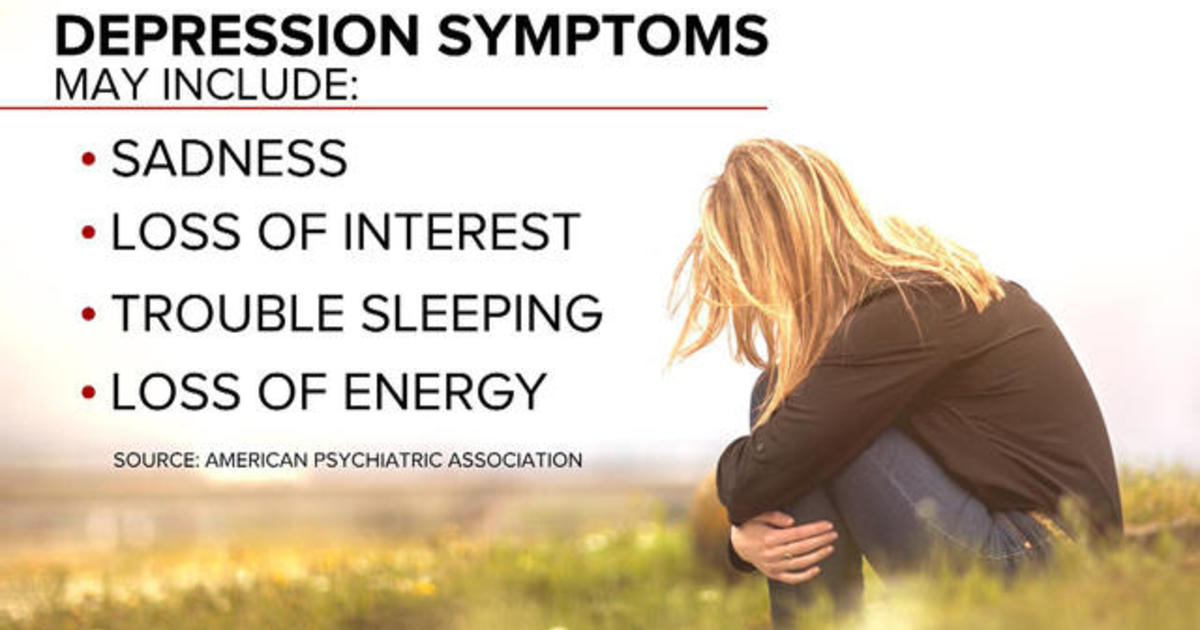Trileptal for mood
Trileptal (Oxcarbazepine) for Bipolar Disorder
What is Trileptal? Trileptal is a medication known as an anticonvulsant that is used to treat seizures. It is also sometimes used as a mood stabilizer to treat the symptoms of bipolar disorder.
When did the U.S. Food and Drug Administration (FDA) approve the medication? Trileptal was approved by the FDA in 2000.
Is there a generic version of Trileptal? Yes, the generic version is known as oxcarbazepine and is sold in the US.
Are there any major differences between Trileptal and other medications used to treat bipolar disorder? Trileptal belongs to the class of medications known as anticonvulsants. Anticonvulsants are sometimes prescribed to treat manic and depressive episodes associated with bipolar disorder. Trileptal may be prescribed in combination with other medications to treat symptoms. Talk to your doctor about the potential risks and benefits of taking Trileptal.
Can children take Trileptal? Children are prescribed Trileptal for seizures, but the effectiveness and safety of use for bipolar disorder has not been established. Talk to your child’s doctor about the risks and benefits and potential side effects to monitor.
Are there potential interaction issues for people taking Trileptal and any other drugs? There are hundreds of drugs which are known to interact with Trileptal in major, moderate, or mild ways, so let your doctor know what other medications you are taking before you begin taking the medication. Some of these might include amiodarone, amitriptyline, calcium channel blockers, chlorpromazine, clomipramine, cyclophosphamide, desmopressin, diazepam, diuretics, hormonal contraceptives, other anticonvulsants, proton-pump inhibitors, theophylline, and selective serotonin reuptake inhibitors. The medication can also decrease the effectiveness of hormonal contraceptives.
Are there any other medical conditions that would make someone ineligible for Trileptal therapy? Talk to your doctor about other medical conditions before you take Trileptal, such as kidney or liver disease.
What is the typical dose that would be prescribed to someone taking Trileptal? Dosage will vary depending on the age of the patient and the condition being treated.
What do I do if I miss a dose? You should never take extra doses of the medication to make up for missed doses. Talk to your doctor about how long you should wait in between doses.
What side effects can Trileptal cause? Common side effects can include:
It also is recommended that you wait to drive or operate machinery until you know how the medication affects you. It is also recommended that people avoid alcohol and illegal drugs while on the medication, as they can worsen adverse effects. Report major side effects to your doctor immediately, which can include swelling, thirst, nausea, vomiting, headache, confusion, decreased alertness, rash, fever, blisters, irritated eyes, blotches on skin, yellowing of skin or eyes, bleeding or bruising, joint pain, chest pain, signs of infection, or changes in urination. You can also report side effects to the FDA at 1-800-FDA-1088 or online.
What are the potential psychological side effects of taking Trileptal? Taking anticonvulsant medications can sometimes result in increased suicidal thoughts and behaviors in a small percentage of people. Seek medical help if you experience these thoughts or other changes in your behavior or mood.
Seek medical help if you experience these thoughts or other changes in your behavior or mood.
Is it safe for a woman who is pregnant, about to become pregnant, or nursing to take Trileptal? Trileptal may cause birth defects and fetal harm when taken during pregnancy. The drug can be transferred via breast milk and potentially harm a baby. Therefore, talk to your doctor if you are pregnant, planning to become pregnant, or are nursing before you take Trileptal. The medication can also impact the effectiveness of hormonal contraceptives.
Can symptoms occur if Trileptal is discontinued? It’s important not to discontinue use of the drug before talking with your doctor. Withdrawal symptoms of Trileptal can include insomnia and return of seizures or bipolar symptoms (depending on the purpose of taking the medication).
What should I do if I overdose on Trileptal? An overdose of Trileptal could be fatal, so seek immediate help or call the Poison Help Line at 1-800-222-1222 if you overdose. Overdose symptoms can include dizziness, sedation, decreased heart rate, low blood pressure, low sodium levels, seizures, and coma.
Overdose symptoms can include dizziness, sedation, decreased heart rate, low blood pressure, low sodium levels, seizures, and coma.
Is Trileptal habit-forming? Trileptal is not habit-forming, but it is not recommended that you discontinue use of the drug before talking with your doctor, as withdrawal symptoms can occur.
How much does Trileptal cost? According to goodrx.com, 60 tablets of 300 mg generic oxcarbazepine cost approximately $86.50. Sixty tablets of 300 mg Trileptal cost approximately $160.66.
Are there any disadvantages to Trileptal? The biggest disadvantages of Trileptal are potential side effects. Pregnant women are also typically advised not to take the medication due to the risks.
DISCLAIMER: The information contained herein should NOT be used as a substitute for the advice of an appropriately qualified and licensed physician or other healthcare providers. This article mentions drugs that were FDA-approved and available at the time of publication and may not include all possible drug interactions or all FDA warnings or alerts. The author of this page explicitly does not endorse this drug or any specific treatment method. If you have health questions or concerns about interactions, please check with your physician or go to the FDA site for a comprehensive list of warnings.
The author of this page explicitly does not endorse this drug or any specific treatment method. If you have health questions or concerns about interactions, please check with your physician or go to the FDA site for a comprehensive list of warnings.
- FDA – Trileptal
- NIH – Oxcarbazepine
Notes: This article was originally published January 2, 2017 and most recently updated September 12, 2022.
Mental Health Medications | NAMI: National Alliance on Mental Illness
Brand names: Trileptal®, Oxtellar XR®
- Tablet: 150 mg, 300 mg, 600 mg
- Liquid: 300 mg/5 mL
- Extended-release tablet: 150 mg, 300 mg, 600 mg
Generic name: oxcarbazepine (ox car BAZ e peen)
All FDA black box warnings are at the end of this fact sheet. Please review before taking this medication.
What Is Oxcarbazepine And What Does It Treat?
Oxcarbazepine is an antiepileptic medication that works in the brain to prevent and control seizures. It is approved for the treatment of partial seizures.
It is approved for the treatment of partial seizures.
Oxcarbazepine may also be helpful when prescribed “off-label” for nerve pain or as a mood stabilizer for bipolar disorder. “Off-label” means that it hasn’t been approved by the Food and Drug Administration for this condition. Your mental health provider should justify his or her thinking in recommending an “off-label” treatment. They should be clear about the limits of the research around that medication and if there are any other options.
Bipolar disorder involves episodes of depression and/or mania.
Symptoms of depression include:
- Depressed mood — feeling sad, empty, or tearful
- Feeling worthless, guilty, hopeless, or helpless
- Loss of interest or pleasure in normal activities
- Sleep and eat more or less than usual (for most people it is less)
- Low energy, trouble concentrating, or thoughts of death (suicidal thinking)
- Psychomotor agitation (‘nervous energy’)
- Psychomotor retardation (feeling like you are moving in slow motion)
Symptoms of mania include:
- Feeling irritable or “high”
- Having increased self esteem
- Feeling like you don’t need to sleep
- Feeling the need to continue to talk
- Feeling like your thoughts are too quick (racing thoughts)
- Feeling distracted
- Getting involved in activities that are risky or could have bad consequences (e.
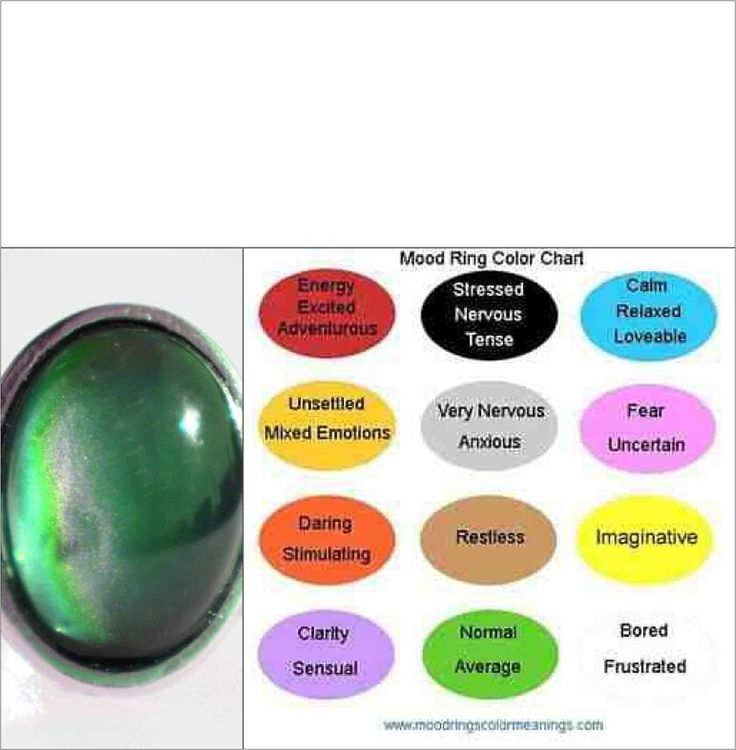 g., excessive spending)
g., excessive spending)
What Is The Most Important Information I Should Know About Oxcarbazepine?
Bipolar disorder requires long-term treatment. Do not stop taking oxcarbazepine, even when you feel better. With input from you, your health care provider will assess how long you will need to take the medicine. Missing doses of oxcarbazepine may increase your risk for a relapse in your mood symptoms.
Do not stop taking oxcarbazepine or change your dose without talking to with your healthcare provider first.
In order for oxcarbazepine to work properly, it should be taken every day as ordered by your healthcare provider.
Periodically, your healthcare provider may ask you to provide a blood sample to make sure the appropriate level of medication is in your body and to assess for side effects, such as changes in blood cell counts and sodium levels.
Are There Specific Concerns About Oxcarbazepine And Pregnancy?
If you are planning on becoming pregnant, notify your healthcare provider so that he/she can best manage your medications. People living with bipolar disorder who wish to become pregnant face important decisions. It is important to discuss the risks and benefits of treatment with your doctor and caregivers.
People living with bipolar disorder who wish to become pregnant face important decisions. It is important to discuss the risks and benefits of treatment with your doctor and caregivers.
Oxcarbazepine has been associated with an increased risk of craniofacial defects and heart malformations. There may be precautions to decrease the risk of this effect. Do not stop taking oxcarbazepine without first speaking to your healthcare provider. Discontinuing mood stabilizer medications during pregnancy has been associated with a significant increase in symptom relapse.
Regarding breast-feeding, caution is advised since oxcarbazepine does pass into breast milk.
What Should I Discuss With My Healthcare Provider Before Taking Oxcarbazepine?
- Symptoms of your condition that bother you the most
- If you have thoughts of suicide or harming yourself
- Medications you have taken in the past for your condition, whether they were effective or caused any adverse effects
- If you experience side effects from your medications, discuss them with your provider.
 Some side effects may pass with time, but others may require changes in the medication.
Some side effects may pass with time, but others may require changes in the medication. - Any other psychiatric or medical problems you have
- All other medications you are currently taking (including over the counter products, herbal and nutritional supplements) and any medication allergies you have
- Other non-medication treatment you are receiving, such as talk therapy or substance abuse treatment. Your provider can explain how these different treatments work with the medication.
- If you are pregnant, plan to become pregnant, or are breast-feeding
- If you drink alcohol or use illegal drugs
How Should I Take Oxcarbazepine?
Oxcarbazepine is usually taken once or twice a day with or without food.
Typically patients begin at a low dose of medicine and the dose is increased slowly over several weeks.
The dose usually ranges from 900-1200 mg per day. People taking this medication for seizure control may take up to 2400 mg daily. Only your healthcare provider can determine the correct dose for you.
Only your healthcare provider can determine the correct dose for you.
Oxcarbazepine suspension: Measure your dose with a dosing spoon or oral syringe, which you can get from your pharmacy. Before using, shake the bottle well to ensure the medicine is mixed thoroughly. Your dose can be mixed in a small glass of water just prior to taking or may be swallowed directly from the dosing spoon.
Use a calendar, pillbox, alarm clock, or cell phone alert to help you remember to take your medication. You may also ask a family member or a friend to remind you or check in with you to be sure you are taking your medication.
What Happens If I Miss A Dose Of Oxcarbazepine?
If you miss a dose of oxcarbazepine, take it as soon as you remember, unless it is closer to the time of your next dose. Discuss this with your healthcare provider. Do not double your dose or take more than what is prescribed.
What Should I Avoid While Taking Oxcarbazepine?
Avoid drinking alcohol or using illegal drugs while you are taking oxcarbazepine.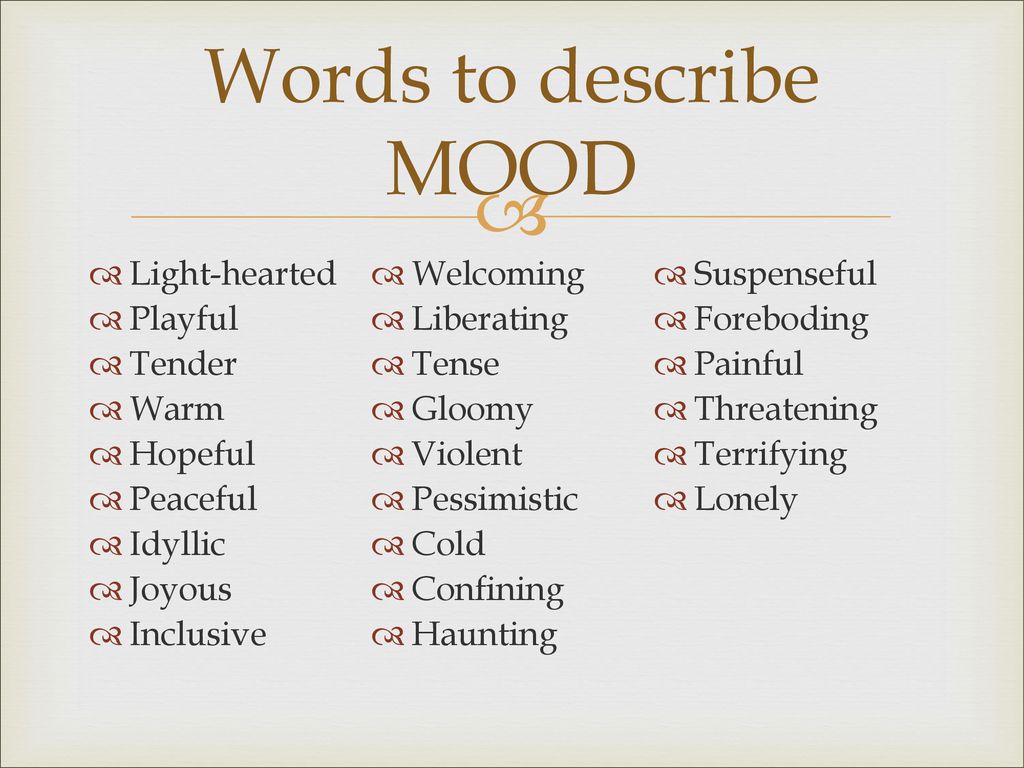 They may decrease the benefits (e.g., worsen your condition) and increase adverse effects (e.g., sedation, dizziness) of the medication.
They may decrease the benefits (e.g., worsen your condition) and increase adverse effects (e.g., sedation, dizziness) of the medication.
What Happens If I Overdose With Oxcarbazepine?
If an overdose occurs call your doctor or 911. You may need urgent medical care. You may also contact the poison control center at 1-800-222-1222.
A specific treatment to reverse the effects of oxcarbazepine does not exist.
What Are Possible Side Effects Of Oxcarbazepine?
Common side effects
- Dizziness
- Drowsiness
- Vision changes
- Nausea/vomiting
- Headache
- Fatigue
- Uncoordinated movements
- Tremor
Rare/serious side effects
Oxcarbazepine can cause a decrease in the body’s sodium level. Some signs of low sodium include nausea, tiredness, lack of energy, headache, confusion, or more frequent or more severe seizures.
Oxcarbazepine may also cause allergic reactions or serious problems which may affect organs and other parts of your body like the liver or blood cells. You may or may not have a rash with these types of reactions.
You may or may not have a rash with these types of reactions.
In rare cases (<1%) a severe, spreading rash with blistering of the skin in patches over the entire body along with fever, headache and cough can occur (Stevens-Johnson syndrome). Although this is rare with oxcarbazepine, discontinuation of this medication is necessary. Rare cases of severe allergic reactions have been reported. Symptoms include swelling of the face, eyes, lips, or tongue, difficulty swallowing or breathing. If you experience any of these side effects, it is important to seek medical care immediately.
Studies have found that individuals who take antiepileptic medications including oxcarbazepine may be twice as likely to have suicidal thoughts or behaviors as individuals who take placebo (inactive medication). These thoughts or behaviors are rare and occurred in approximately 1 in 500 patients taking the antiepileptic class of medications. If you experience any thoughts or impulses to hurt yourself, you should contact your doctor immediately.
Are There Any Risks For Taking Oxcarbazepine For Long Periods Of Time?
To date, there are no known problems associated with long term use of oxcarbazepine. It is a safe and effective medication when used as directed.
It is important to note that some of the side effects listed above (particularly changes in blood sodium, rash, and suicidal thoughts) may continue to occur or worsen if you continue taking the medication. It is important to follow up with your doctor for blood work and to contact your doctor immediately if you notice any skin rash or changes in mood or behavior.
What Other Medications May Interact With Oxcarbazepine?
The seizure medications phenobarbital and phenytoin may decrease the effects of oxcarbazepine.
Oxcarbazepine may increase the effects of phenobarbital and phenytoin.
Oxcarbazepine may decrease the level and effects of:
- Oral contraceptives (birth control pills)
- Anti-rejection medications used in organ transplants, like tacrolimus (Prograf®) and cyclosporine (Neoral®, Sandimmune®)
- Certain blood pressure medications, such as amlodipine (Norvasc®) or felodipine (Plendil®)
How Long Does It Take For Oxcarbazepine To Work?
It is very important to tell your doctor how you feel things are going during the first few weeks after you start taking oxcarbazepine and whether or not you are experiencing any side effects from the medication.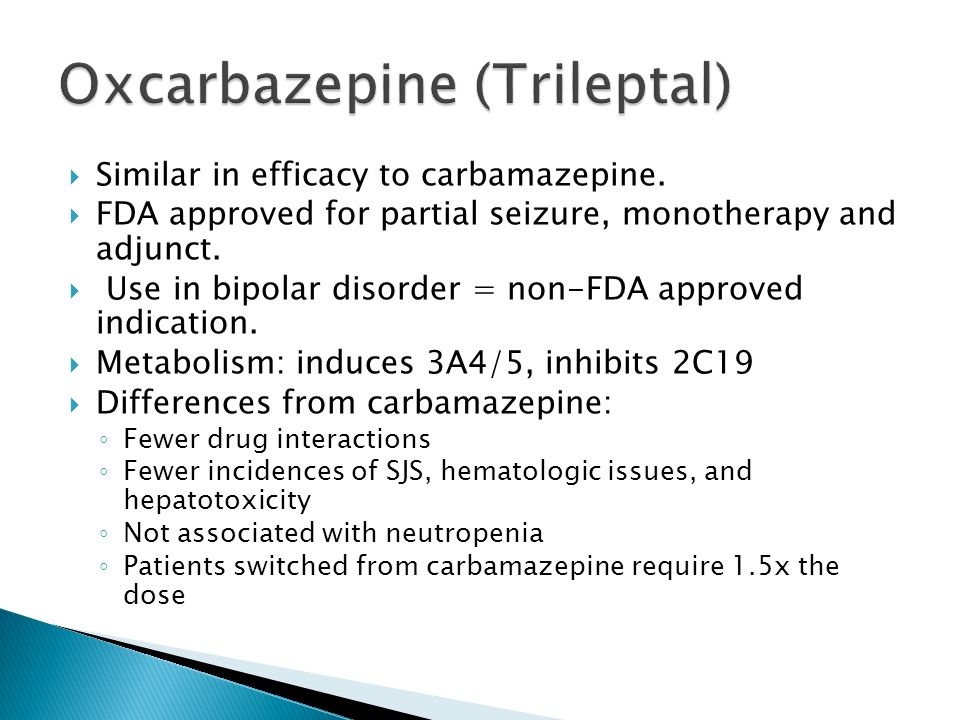 It will probably take several weeks to see big enough changes in your symptoms to decide if oxcarbazepine is the right medication for you.
It will probably take several weeks to see big enough changes in your symptoms to decide if oxcarbazepine is the right medication for you.
Mood stabilizer treatment is generally needed lifelong for persons with bipolar disorder. Your doctor can best discuss the duration of treatment you need based on your symptoms and illness.
Summary of FDA Black Box Warnings
There are no FDA black box warnings for oxcarbazepine.
Provided by
(June 2019)
©2019 The College of Psychiatric and Neurologic Pharmacists (CPNP) and the National Alliance on Mental Illness (NAMI). CPNP and NAMI make this document available under the Creative Commons Attribution-No Derivatives 4.0 International License. Last Updated: January 2016.
This information is being provided as a community outreach effort of the College of Psychiatric and Neurologic Pharmacists. This information is for educational and informational purposes only and is not medical advice.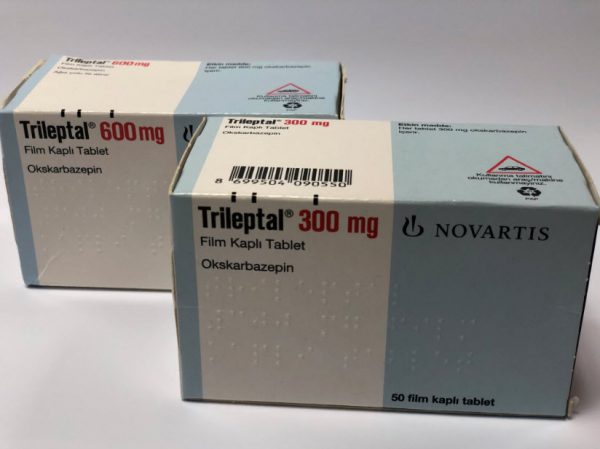 This information contains a summary of important points and is not an exhaustive review of information about the medication. Always seek the advice of a physician or other qualified medical professional with any questions you may have regarding medications or medical conditions. Never delay seeking professional medical advice or disregard medical professional advice as a result of any information provided herein. The College of Psychiatric and Neurologic Pharmacists disclaims any and all liability alleged as a result of the information provided herein.
This information contains a summary of important points and is not an exhaustive review of information about the medication. Always seek the advice of a physician or other qualified medical professional with any questions you may have regarding medications or medical conditions. Never delay seeking professional medical advice or disregard medical professional advice as a result of any information provided herein. The College of Psychiatric and Neurologic Pharmacists disclaims any and all liability alleged as a result of the information provided herein.
New gold standard | www.mgzt.ru
Within the framework of the VI All-Russian Congress of Neurologists held in Yaroslavl, a symposium "New possibilities for the use of antiepileptic drugs in neurology" was held, which was organized by Novartis Pharma Services Inc. The presidium of the scientific meeting included Academician of the Russian Academy of Medical Sciences Nikolai Yakhno, Chairman of the Russian Anti-Epileptic League Professor Gagik Avakyan, Secretary of the Russian Anti-Epileptic League Professor Alla Gekht, Chief Expert Pediatric Neurologist of the Ministry of Health and Social Development of Russia Professor Larisa Kalinina. nine0004
nine0004
Differences and advantages
Professor Konstantin Mukhin (Russian State Medical University) opened the symposium with the report “Clinical experience with Trileptal (oxcarbazepine) in symptomatic focal epilepsy”. He spoke in detail about the history of creation and requirements for antiepileptic drugs, which include high efficiency in the treatment of epilepsy, a wide range of effects on various seizures, the absence of seizure aggravation, and good tolerance. nine0005 The speaker dwelled on the general principles of epilepsy treatment - the effectiveness of monotherapy, prescribing drugs depending on the form of the disease, the nature of the attacks and the age of the patients. It was emphasized that if a drug was not effective enough, it should be gradually withdrawn and replaced by another.
Pharmacoeconomic data were presented, according to which, per inpatient, only antiepileptic drugs in Germany were spent per month in 1986 - 28 euros, in 1992 - 33 euros, in 2001 - 70 euros (when new generation drugs entered clinical practice), in 2002 - 92 euros.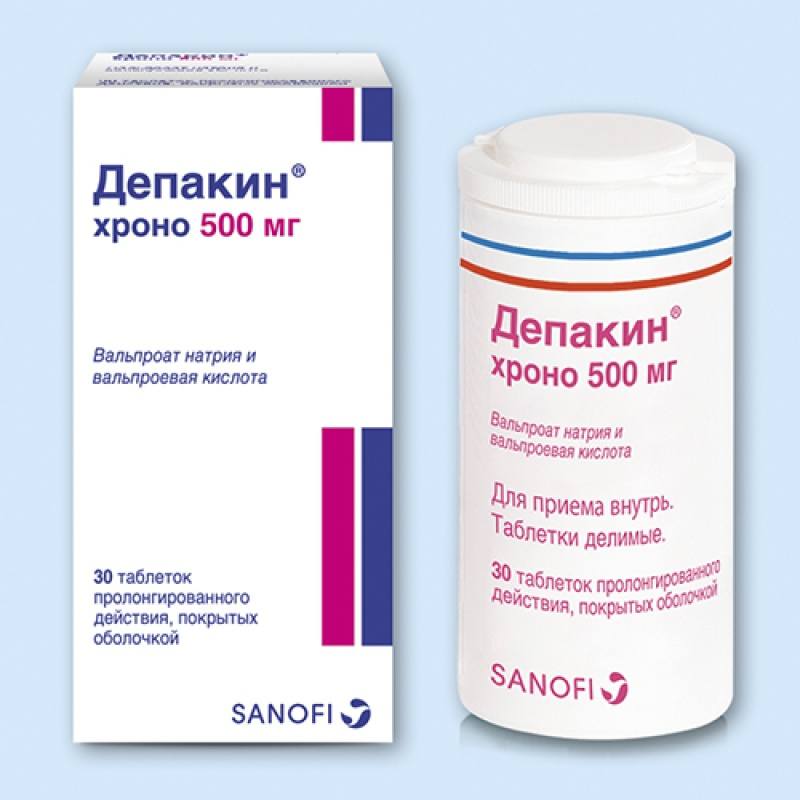 The author stressed that this figure will grow due to the cost of modern drugs for the treatment of epilepsy. However, the costs to society associated with the disability of patients with epilepsy are much greater, which is why the availability of new effective drugs is important.
The author stressed that this figure will grow due to the cost of modern drugs for the treatment of epilepsy. However, the costs to society associated with the disability of patients with epilepsy are much greater, which is why the availability of new effective drugs is important.
Trileptal (oxcarbazepine) is a drug that has become firmly established in clinical practice and has been used in some countries for 10 years. It preferentially blocks voltage-gated sodium and calcium channels, peaking at 4.5 hours after oral administration of 600 mg. Trileptal has a linear pharmacokinetics, unlike, for example, otdifenin and phenytoin, where, due to non-linear pharmacokinetics, even with a small increase in dose, it is possible to quickly reach a peak concentration and get a toxic effect. nine0005 The binding of Trileptal to plasma proteins is low - 40%. This is especially important in pediatric practice, where drugs with high plasma protein binding must be used with caution.
The fundamental difference between Trileptal and drugs of the carbamazepine group is a different metabolic pathway with the formation of a completely different metabolite - monohydroxy derivative. Thus, during the transformation of Trileptal, the body does not form 10,11 epoxide, the active metabolite of carbamazepine, which is traditionally associated with its main side effects. A side effect that is possible when taking both carbamazepine and Trileptal is hyponatremia, that is, a decrease in the level of sodium in the blood plasma of less than 120 mmol / l. Hyponatremia occurs more often in adults, especially in the elderly; in pediatric practice, hyponatremia is rare. nine0005 The half-life is on average 2.5 hours for Trileptal itself (oxcarbazepine) and 9.5 hours for its metabolite, monohydroxy derivative, which allows you to take the drug 2 times a day. 95% of the drug is metabolized in the kidneys.
Thus, during the transformation of Trileptal, the body does not form 10,11 epoxide, the active metabolite of carbamazepine, which is traditionally associated with its main side effects. A side effect that is possible when taking both carbamazepine and Trileptal is hyponatremia, that is, a decrease in the level of sodium in the blood plasma of less than 120 mmol / l. Hyponatremia occurs more often in adults, especially in the elderly; in pediatric practice, hyponatremia is rare. nine0005 The half-life is on average 2.5 hours for Trileptal itself (oxcarbazepine) and 9.5 hours for its metabolite, monohydroxy derivative, which allows you to take the drug 2 times a day. 95% of the drug is metabolized in the kidneys.
An important advantage of oxcarbazepine is that, unlike the drugs of the carbamazepine group, it is a weak inducer of microsomal liver enzymes and does not affect the metabolism of other drugs. Thus, it is convenient to combine oxcarbazepine with other antiepileptic drugs, knowing that their concentration will not change significantly. However, caution should be exercised when using oxcarbazepine while taking oral contraceptives. nine0005
However, caution should be exercised when using oxcarbazepine while taking oral contraceptives. nine0005
Trileptal is currently positioned as a starting monotherapy for symptomatic focal forms of epilepsy in adults and children over 2 years of age. In the near future, Trileptal suspension for very young children will be approved for use.
The second indication is the use as adjunctive therapy for symptomatic forms of focal epilepsy. Trileptal is contraindicated in patients with typical absence seizures or myoclonus within idiopathic generalized forms of epilepsy. nine0005 Dosages for children - from 8 to 46 mg / kg of body weight per day, the average dose is 20-30 mg / kg of body weight per day in two divided doses. For adults - 10-45 mg per kg of body weight per day, an average of 1000 mg / day. The starting dose ranges from 150 mg/day in young children to 300 mg/day in older children, followed by a weekly increase in dose from 150 to 200 mg. For adults, it is also possible to titrate the dose from 150 mg with a further weekly increase in the dose by 600 mg.
According to clinical studies, in 90% of patients with partial epilepsy, a decrease in the frequency of seizures by more than 50% was observed, and in 60% of patients with newly diagnosed epilepsy, complete relief of seizures was observed with Trileptal monotherapy. nine0005 The drug demonstrates the highest percentage of retention on therapy - up to 91% of patients continue to take Trileptal during the year. Interruption of therapy due to side effects - only 3%. An important point - if necessary, it is possible to replace other antiepileptic drugs with Trileptal "overnight", that is, switching drugs can be one-step.
Therapy of neuropathic pain
Professor Valery Alekseev (Moscow Medical Academy named after I.M. Sechenov) in the report "Anticonvulsants in the treatment of neuropathic pain" spoke in detail about the functioning of the nociceptive and antinociceptive systems, the mechanisms of pain formation, and gave characteristics to various types of pain. nine0005 The therapy strategy for neuropathic pain is based on a complex effect both on the peripheral components of the system that conduct pain, and on the regulation of behavior and the emotional sphere. All anticonvulsants used to treat neuropathic pain are conditionally divided into three groups: blockers of voltage-gated sodium channels; drugs that enhance GABA-ergic activity; drugs that block the release of activating amino acids (glutamate and aspartate). Trileptal blocks voltage-dependent sodium and calcium channels, opens potassium channels, that is, creates the effect of membrane hyperpolarization, as a result, the peripheral nociceptive stimulus is not perceived, according to the “busy here” principle, and finally blocks the release of activating amino acids, which complements the overall effect against the formation of neuropathic pain . It is important that with the combined use of a wide range of drugs with an effect on peripheral receptor apparatus, Trileptal has practically no interaction with other drugs, that is, it can be actively used in complex treatment.
nine0005 The therapy strategy for neuropathic pain is based on a complex effect both on the peripheral components of the system that conduct pain, and on the regulation of behavior and the emotional sphere. All anticonvulsants used to treat neuropathic pain are conditionally divided into three groups: blockers of voltage-gated sodium channels; drugs that enhance GABA-ergic activity; drugs that block the release of activating amino acids (glutamate and aspartate). Trileptal blocks voltage-dependent sodium and calcium channels, opens potassium channels, that is, creates the effect of membrane hyperpolarization, as a result, the peripheral nociceptive stimulus is not perceived, according to the “busy here” principle, and finally blocks the release of activating amino acids, which complements the overall effect against the formation of neuropathic pain . It is important that with the combined use of a wide range of drugs with an effect on peripheral receptor apparatus, Trileptal has practically no interaction with other drugs, that is, it can be actively used in complex treatment. nine0005 There are data on the use of Trileptal in traumatic lesions of the spinal cord, complex regional pain syndrome type 1, postherpetic neuralgia, trigeminal neuralgia, diabetic neuropathy with pain syndrome.
nine0005 There are data on the use of Trileptal in traumatic lesions of the spinal cord, complex regional pain syndrome type 1, postherpetic neuralgia, trigeminal neuralgia, diabetic neuropathy with pain syndrome.
Mood corrector
Prof. Olga Vorobyeva (MMA named after I.M. Sechenov) made a report on the Normothymic Effects of Antiepileptic Drugs.
After the introduction of the first anticonvulsants to the market, it became clear that in addition to their effect on epileptic seizures, they affect psychopathological syndromes. nine0005 Primarily, anticonvulsants can be used for mood disorders.
Mood disorders are divided into bipolar and depressive, these disorders are extremely numerous. And if neurologists do not encounter bipolar disorders of the 1st type, when manias are replaced by depression, in their practice, they constantly encounter bipolar disorder of the 2nd type, in which mania does not reach the degree of manic psychosis. These are shallow, mild depressions, mood disorders induced by drugs used in neurology or caused by somatic suffering, including neurological.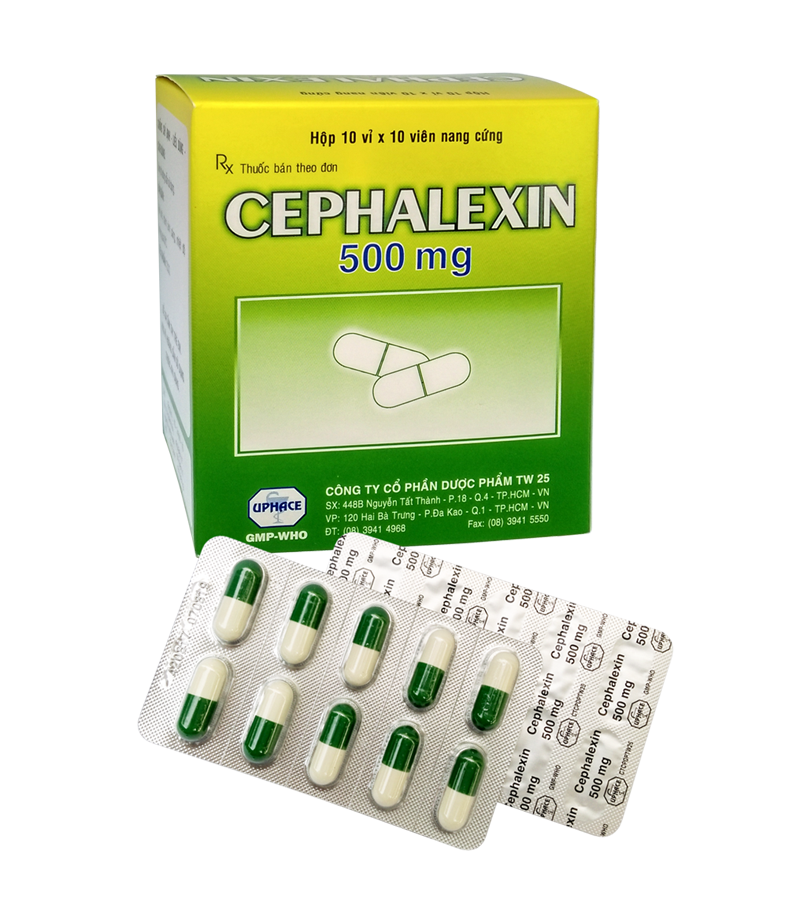 nine0005 Anticonvulsants stabilize mood and are commonly referred to as mood correctors. Bipolar disorder is characterized by alternating manic and depressive episodes, with each successive episode requiring a lesser trigger. The gaps between the phases shorten, similar to the epilepsy model, where each seizure paves the way for the next.
nine0005 Anticonvulsants stabilize mood and are commonly referred to as mood correctors. Bipolar disorder is characterized by alternating manic and depressive episodes, with each successive episode requiring a lesser trigger. The gaps between the phases shorten, similar to the epilepsy model, where each seizure paves the way for the next.
First-generation anticonvulsants have proven to be truly mood stabilizing, highly effective for acute mania and long-term treatment of bipolar disorder. Modern anticonvulsants entering the market do not have such a stabilizing effect. Some of them are effective against PTSD, post-stress anxiety, some are effective against depression, but not enough to be called mood correctors. New generation drugs have a narrower, selective psychotropic spectrum. nine0005 Looking at the level of sales of anticonvulsants, it is clear that first-generation drugs remain very attractive. Therefore, now some new drugs are being developed on the basis of molecules of the first generation of anticonvulsants. Trileptal is very close in action to carbamazepine and retains its effects with a much more favorable tolerability spectrum. Trileptal gives fewer allergic reactions compared to carbamazepine and, which is very important for the treatment of psychopathological syndromes, interacts significantly less with psychotropic drugs, it has better performance in combined treatment, no matter what it is prescribed with - anticonvulsants or psychotropic drugs. nine0005 Trileptal (oxcarbazepine) is similar in its mechanisms of action and clinical effects to carbamazepine and can be used as a mood corrector, for the treatment of manic-depressive psychosis, while mainly for the treatment of mania (for the correction of depression in doctors, there is already a fairly large arsenal of drugs) . As a mood corrector, the drug has been investigated in four large controlled trials, where dosages from 900 to 2300 mg per day were used. Its action was compared with antipsychotics (haloperidol), lithium and placebo.
Trileptal is very close in action to carbamazepine and retains its effects with a much more favorable tolerability spectrum. Trileptal gives fewer allergic reactions compared to carbamazepine and, which is very important for the treatment of psychopathological syndromes, interacts significantly less with psychotropic drugs, it has better performance in combined treatment, no matter what it is prescribed with - anticonvulsants or psychotropic drugs. nine0005 Trileptal (oxcarbazepine) is similar in its mechanisms of action and clinical effects to carbamazepine and can be used as a mood corrector, for the treatment of manic-depressive psychosis, while mainly for the treatment of mania (for the correction of depression in doctors, there is already a fairly large arsenal of drugs) . As a mood corrector, the drug has been investigated in four large controlled trials, where dosages from 900 to 2300 mg per day were used. Its action was compared with antipsychotics (haloperidol), lithium and placebo. With regard to haloperidol, oxcarbazepine has a similar efficacy, and in some aspects looks more attractive, the same with lithium. nine0005 Trileptal (oxcarbazepine) is used as a mood corrector at dosages of 900-1200 mg per day. Neurologists deal with incomplete syndromes and use mainly the dosage of 900 mg per day. Psychiatrists use dosages sometimes significantly higher than 1200 mg per day.
With regard to haloperidol, oxcarbazepine has a similar efficacy, and in some aspects looks more attractive, the same with lithium. nine0005 Trileptal (oxcarbazepine) is used as a mood corrector at dosages of 900-1200 mg per day. Neurologists deal with incomplete syndromes and use mainly the dosage of 900 mg per day. Psychiatrists use dosages sometimes significantly higher than 1200 mg per day.
Albert KHISAMOV , corr. "MG".
‹ Where are Piglet and I going? Up I forgot what candles are lit on New Year's Eve... ›
Memorial Sloan Kettering Cancer Center
Adult Medication
ShareThis document, provided by Lexicomp ® , contains all the information you need to know about this medicine, including indications, directions for use, side effects, and when your healthcare provider should be contacted.
Trade names: US
Oxtellar XR; Trileptal
Trade names: Canada
APO-OXcarbazepine; JAMP-OXcarbazepine [DSC]; Trileptal
What is this drug used for?
- Used to control certain types of seizures.

- This drug may also be used for other indications. Consult your doctor.
What should I tell my doctor BEFORE taking this drug?
- If you have an allergy to this drug, any of its ingredients, other drugs, foods or substances. Tell your doctor about your allergies and how they have manifested. nine0054
- If you have liver disease.
- If you have been tested and it turns out that you have a variant of the gene called HLA-B*1502.
This list of drugs and conditions that may interact with this drug is not exhaustive.
Tell your doctor and pharmacist about all medicines you take (prescription and over-the-counter, natural products and vitamins) and any health problems you have. You need to make sure that this drug is safe for your conditions and in combination with other drugs you are already taking. Do not start or stop taking any drug or change the dosage without your doctor's advice. nine0045
What do I need to know or do while taking this drug?
- Tell all your health care workers that you are taking this drug.
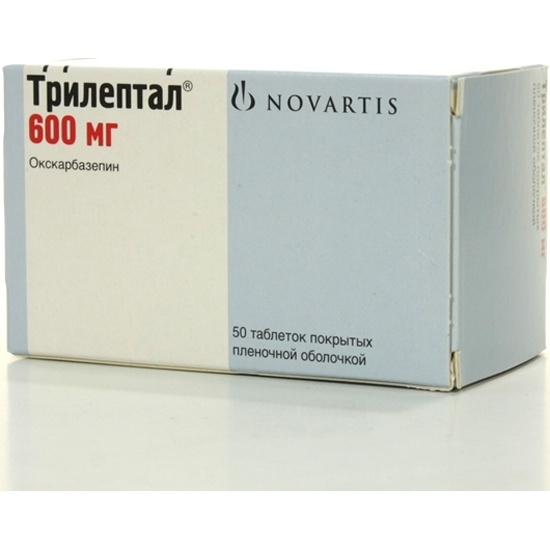 These are doctors, nurses, pharmacists and dentists.
These are doctors, nurses, pharmacists and dentists. - Avoid driving and other activities that require increased attention until you see how this drug affects you.
- Perform blood tests as directed by your doctor. Consult with your doctor. nine0054
- Check with your doctor before using alcohol, marijuana or other forms of cannabis, or prescription or over-the-counter drugs that can slow you down.
- Talk to your doctor if your seizures change or get worse after you start taking this drug.
- Like other seizure medicines, this medicine can rarely increase the risk of suicidal ideation or behavior. This risk may be higher in people who have tried or had suicidal thoughts in the past. Call your doctor right away if you develop or worsen symptoms such as depression, nervousness, anxiety, irritability, panic attacks, or other mood or behavioral disturbances. If you have suicidal thoughts or attempted suicide, contact your doctor immediately. nine0054
- Possible severe skin reaction (Stevens-Johnson syndrome/toxic epidermal necrolysis).
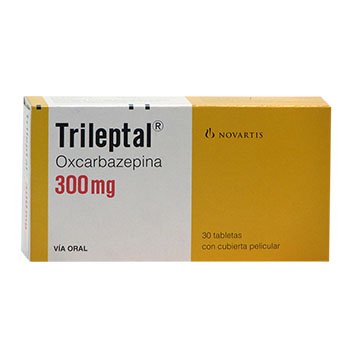 This can lead to severe health problems, which can be permanent, and sometimes death. Seek immediate medical attention if you experience symptoms such as redness, swelling of the skin with blistering or peeling (with or without fever), redness or irritation of the eyes, and sores in the mouth, throat, nose, or eyes. nine0054
This can lead to severe health problems, which can be permanent, and sometimes death. Seek immediate medical attention if you experience symptoms such as redness, swelling of the skin with blistering or peeling (with or without fever), redness or irritation of the eyes, and sores in the mouth, throat, nose, or eyes. nine0054 - People with a certain gene (HLA-B*1502) are more likely to have serious and sometimes fatal skin reactions associated with this drug. This gene is most common among Asians, including South Asian Indians. If you have any questions, please consult your doctor.
- A very bad reaction called angioedema has happened with this drug. Sometimes this reaction can be life-threatening. Symptoms may include swelling of the hands, face, lips, eyelids, tongue, or throat, difficulty breathing or swallowing, or an uncharacteristic hoarse voice. If any of these symptoms occur, seek medical attention immediately. nine0054
- If you are 65 years of age or older, use this drug with caution.
 You may experience more side effects.
You may experience more side effects. - The effectiveness of birth control pills and other hormonal birth control may decrease. Use other types of birth control, such as a condom, in addition to taking this drug.
- When used during pregnancy, the drug may have a harmful effect on the fetus. If you are pregnant or become pregnant while taking this drug, call your doctor right away. nine0054
- The effectiveness of this drug in controlling seizures may be reduced during pregnancy. If you have any questions, please consult your doctor.
- Tell your doctor if you are breastfeeding. It is necessary to consult whether the drug poses any risk to the child.
Which side effects should I report to my doctor immediately?
WARNING. In rare cases, this drug can cause serious and sometimes deadly side effects in some patients. Call your doctor right away or get medical help if you have any of the following signs or symptoms that could be associated with serious side effects:
- Signs of an allergic reaction, such as rash, hives, itching, red and swollen skin with blisters or peeling, possibly accompanied by fever, wheezing or wheezing, tightness in the chest or throat, difficulty breathing, swallowing or speaking, unusual hoarseness, swelling in the mouth, face, lips, tongue or throat.
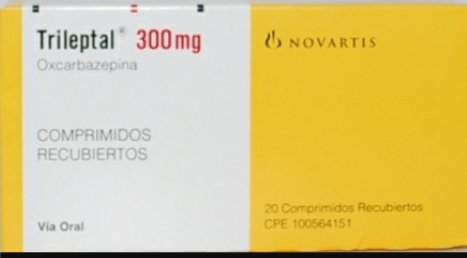
- Signs of low sodium levels such as headache, trouble concentrating, memory impairment, confused thinking, weakness, seizures, problems with balance. nine0054
- Shortness of breath, sudden weight gain, or swelling of the arms or legs.
- Severe muscle pain or weakness.
- Severe pain or inflammation of the joints.
- Confusion of consciousness.
- Distracted attention.
- Change in speech.
- Vision change.
- Loss of control over eye movements.
- Impairment or loss of memory.
- Difficulties with walking.
- Balance change.
- In rare cases, the use of this drug was accompanied by a decrease in the level of blood cells. Seek immediate medical attention if you experience unexplained bruising or bleeding; symptoms of an infection, such as fever, chills, or sore throat; or when you are very tired or weak. nine0054
- Severe and sometimes fatal side effects have occurred in patients taking seizure medications similar to this drug.
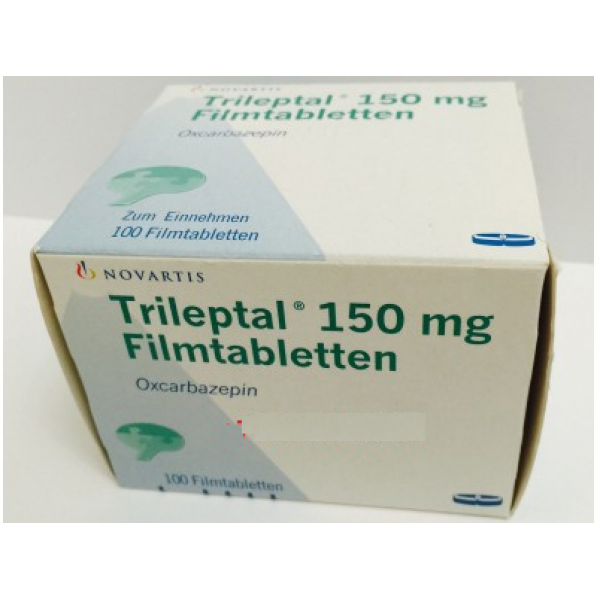 Seek immediate medical attention if swelling of the lymph glands occurs; high temperature; rashes; chest pain; signs of kidney problems, such as inability to urinate or changes in the amount of urine you pass; signs of liver problems such as dark urine, fatigue, lack of appetite, nausea or abdominal pain, light-colored stools, vomiting, yellowing of the skin or eyes. nine0054
Seek immediate medical attention if swelling of the lymph glands occurs; high temperature; rashes; chest pain; signs of kidney problems, such as inability to urinate or changes in the amount of urine you pass; signs of liver problems such as dark urine, fatigue, lack of appetite, nausea or abdominal pain, light-colored stools, vomiting, yellowing of the skin or eyes. nine0054
What are some other side effects of this drug?
Any medicine can have side effects. However, for many people, side effects are either minor or non-existent. Contact your doctor or seek medical attention if these or any other side effects bother you or do not go away:
- Headache.
- Feeling dizzy, drowsy, tired or weak. nine0053 Constipation, diarrhea, abdominal pain, nausea, vomiting, or decreased appetite.
- Shiver.
- Nervous tension and agitation.
- Sleep disorders.
- Change in the ability to perceive taste.
- Signs of a cold.
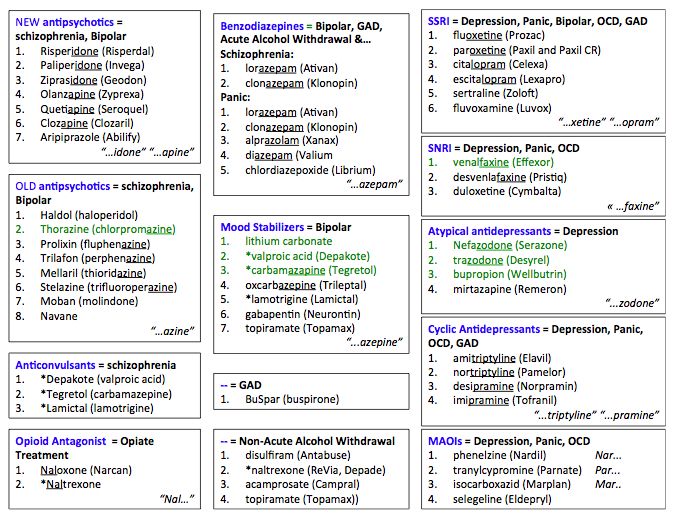
This list of possible side effects is not exhaustive. If you have any questions about side effects, please contact your doctor. Talk to your doctor about side effects. nine0045
You can report side effects to the National Health Office.
You can report side effects to the FDA at 1-800-332-1088. You can also report side effects at https://www.fda.gov/medwatch.
What is the best way to take this drug?
Use this drug as directed by your doctor. Read all the information provided to you. Strictly follow all instructions.
Tablets and liquid form (suspension):
- Take this drug with or without food.
Liquid (suspension):
- Shake well before use.
- Carefully measure liquid doses. Use the measuring container that comes with the medication.
- You can put this drug directly in your mouth or mix it with water in a small glass. nine0054
- Clean the dispenser as instructed.
 If you have any questions about cleaning the dispenser, please read the package insert, consult your doctor or pharmacist.
If you have any questions about cleaning the dispenser, please read the package insert, consult your doctor or pharmacist.
Extended release tablets:
- Take this medicine on an empty stomach. Take 1 hour before meals and 2 hours after meals.
- Swallow whole. Do not chew, break or crush.
All release forms:
- Keep taking this drug as instructed by your doctor or other health care professional, even if you feel well.
- Do not stop taking this drug abruptly without consulting your doctor. This can increase the risk of seizures. If necessary, taking this drug should be stopped gradually, in accordance with the doctor's instructions.
What if I miss a dose of a drug? nine0065
- Take the missed dose as soon as you can.
- If it's time to take your next dose, don't take the missed dose and then go back to your regular dosing schedule.
- Do not take 2 doses or an additional dose at the same time.

How do I store and/or discard this drug?
All editions:
- Store at room temperature with a tightly closed lid. nine0054
- Store in a dry place. Do not store in the bathroom.
- Keep all medicines in a safe place. Keep all medicines out of the reach of children and pets.
- Dispose of unused or expired drugs. Do not empty into a toilet or sewer unless instructed to do so. If you have any questions about disposing of medicines, ask your pharmacist. Drug disposal programs may be in place in your area. nine0054
Extended release tablets:
- Protect from light.
Liquid (suspension):
- Throw away any unused portions of the drug 7 weeks after opening the vial.
- Store in primary container.
General information about medicines
- If your health does not improve or even worsens, see your doctor. nine0054
- Do not give your medicine to anyone and do not take other people's medicines.
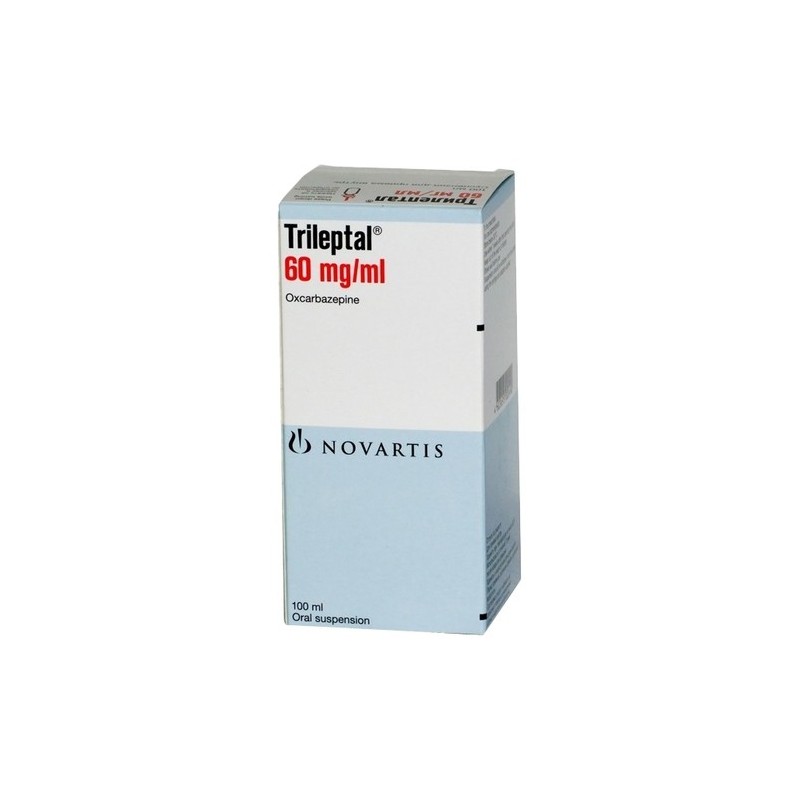
- Some medicines may come with other patient information leaflets. If you have any questions about this drug, talk with your doctor, nurse, pharmacist, or other health care professional.
- A separate instruction for patients is attached to the drug. Please read this information carefully. Reread it each time you refill your supply. If you have any questions about this drug, ask your doctor, pharmacist, or other health care professional. nine0054
- If you think you have overdosed, call a poison control center or get medical help right away. Be prepared to tell or show what drug you took, how much, and when it happened.
Consumer Use of Information and Limitation of Liability
This summary information includes a summary of the diagnosis, treatment and/or drug product. It is not intended to be a comprehensive source of data and should be used as a tool to help the user understand and/or evaluate potential diagnostic and treatment options.

